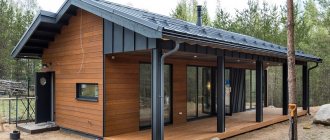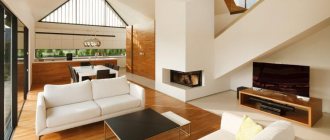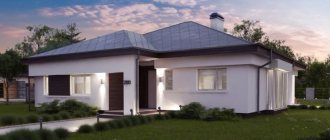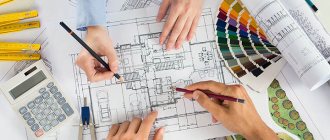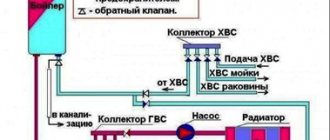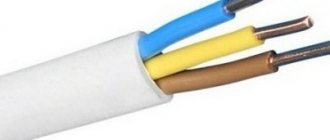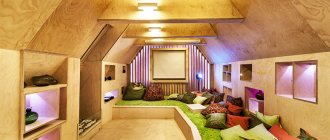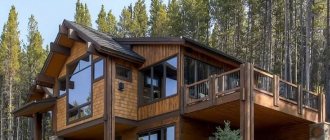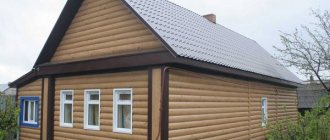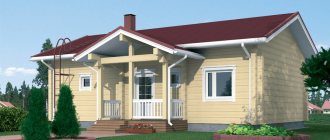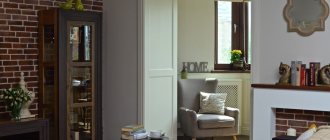Exterior finishing work pursues several main goals, among which an attractive decorative appearance is of no small importance. At the moment, many materials are used, but houses covered with siding look the most original and aesthetically pleasing. The products are presented in a wide stylistic variety, which allows you to realize your design imagination.
Description
The material consists of panels, which subsequently acquire an integral system on the facade of the house. The material used to produce products is varied . Accordingly, each type of siding has its own characteristics and performance characteristics.
There are quite a lot of options for implementing the desired design solution; each type of product has its own color scheme and variety of textures. Basically, the products are characterized by a fairly high level of strength and reliability; they are also profitable to use because their price level is not too high.
Beautiful siding for cladding a house - photo:
What should not be used in the exterior
To minimize errors when choosing the design and colors of the facade, you should consider several nuances:
- No more than three shades on the facade.
- It is better to choose colors in the store itself, and not on the website. Our company provides a visit of a specialist[/anchor] with product samples. This is even more convenient, because you don’t have to go anywhere, but at the same time you will have the opportunity to see the shades of the siding live.
- It is better to select all small details, such as window frames, door openings, drainpipes, cornices in one color.
- Particular attention to the climatic features of the area. For example, for southern regions it is undesirable to use rich dark tones. This way, the siding will deteriorate much faster - the top layer of the panel will actively deteriorate under the rays of the scorching sun.
Advantages and disadvantages
There are a lot of positive characteristics of siding material, the main ones are:
- the period during which siding can be used without problems reaches 50 years;
- Thanks to the finishing with siding panels, the house acquires an attractive appearance . Using this material it is possible to create a variety of styles and realize the most daring design ideas;
- the material does not require special care, there is no need to paint it. It is very easy to handle;
- siding is characterized by lightness and elasticity;
- the process of installing panels is very simple, it requires the efforts of only one person, which allows you to significantly save on a team of workers;
- has high resistance to sudden changes in temperature;
- creates a reliable protective barrier for the surface of the facade of a house finished with siding from the effects of negative destructive environmental phenomena;
- condensation does not form under the surface of the panels, since there are ventilation holes in it that remove accumulated moisture;
- the material is resistant to rotting and corrosion processes, and is also not destroyed due to the activity of insects and microorganisms.
As for the disadvantages of this material, it is worth considering the following points:
- The material from which siding is made is completely synthetic. Accordingly, it does not have a sufficient level of environmental friendliness . This does not apply to the wooden variety of panels, although it is not as reliable as the others.
- Flammability of siding . This point is important in the event of a fire. If the panel begins to melt from the fire, then it releases caustic and toxic substances that are dangerous to the health of people and animals. Stewing products is very difficult.
- If low temperatures persist for a long time, the siding panels become very fragile and may begin to crack . It is even possible for parts of the panel to break off.
- The material is not very resistant to mechanical damage . This is especially important for the metal variety, since for it even a scratch on the surface is a significant threat to quality. The panels cannot be restored, which requires the cost of replacing a damaged panel.
NOTE!
For homes that are exposed to sunlight more often, it's best to choose light-colored siding because it's less prone to fading.
Fastening vertical panels
Self-installation of siding significantly saves consumer costs. In addition, according to experts, it is quite possible without practical experience.
Before starting work, it is advisable to study the instructions for the purchased material and work at least together with a partner.
There are 2 options for installing vertical siding:
- from the corner of the building;
- from the center of the wall of the structure.
The decision on which type of installation to choose should be made based on the design features of the house.
Installation from the center of the wall
If you start installation from the center of the wall, then install 2 initial strips strictly vertically (the process is controlled using a level). They should be tightly adjacent to each other.
Paneling is carried out in different directions from the central planks. One edge of the siding is inserted into the initial strip, and the second is attached to the sheathing using self-tapping screws through special grooves. It is important not to forget to leave gaps: up to 6 mm from the top of the panel, up to 3 mm from the side, as well as around doors and windows. This is done to compensate for the thermal expansion of the material.
Fastening panels from the corner of the building
Installation of vinyl or any other type of vertical siding is carried out from the corner if a clearly symmetrical number of lamellas are laid or the symmetry of the elements does not matter to the home owner.
When installing panels to the corner elements of a building, it is recommended to use a finishing strip. And with the help of special wooden blocks inserted between the siding and corner components, you can level the height of adjacent panels and prevent the occurrence of a ripple effect.
The joint of the panels is covered with strips (connecting and edging). Also, siding can be installed with an overlap (although it is better not to do this on the main facade), and the installation is carried out in stages, so that the distance between the seams is about 5-7 cm.
It is necessary to tighten the screws or drive nails strictly in the center of the factory hole, without pressing on the material or distorting it. Vertical siding is considered installed correctly if the panels move freely within the perforated nail holes. If the slats do not move, be sure to loosen the fastening.
Houses covered with vertical siding look high-quality, aesthetically attractive and exclusive.
Kinds
Those who decide to use siding for finishing work on the facade need to familiarize themselves with the varieties of such material.
Highlight:
- Aluminum . It is characterized by a wide range of different reliefs and colors; this variety is intended for finishing office premises or residential type multi-storey buildings. This is explained by the fact that the panels weigh very little, and therefore will not weigh down the facade of a private house.
- Wooden. It consists of wood fibers that are compressed under high temperature conditions with the addition of a special resin. In appearance they imitate natural wood. The price category of such products is quite high. The panels are characterized by flammability.
- Steel . In most cases, this type is used in industrial construction. The color range is quite wide, the product weighs a lot and is prone to corrosion processes.
- Cement. This variety is one of the newest invented by foreign industry. Has a high level of fire resistance . Made from cement and cellulose fibers. In appearance it resembles wooden boards. Well suited for finishing work in educational institutions and kindergartens. It is also gaining popularity in private construction.
- Ceramic. It is also one of the newest inventions. It has its origins in Japan. The price category of the material is low. Siding contains clay and some other natural materials.
- Vinyl. It is considered the most common and popular because it has an affordable cost, a simple installation process, the ability to hide all defects of the facade surface, and is also resistant to moisture and does not support combustion.
- Metal. A type of siding panels that vary in width. Made from steel (galvanized). During production, a polyester coating is applied to the surface of the product, which protects the material from corrosion. The main advantages of this type are a high level of fire resistance, strength and the longest possible service life . Resistant to a wide temperature range.
CAREFULLY!
When choosing aluminum siding for finishing your house, you must take into account that there is a risk of injury during the installation process. This kind of work should be approached as carefully as possible.
Photos of houses covered with siding of different colors:
How to choose material?
To ensure that the finishing of the house does not disappoint with its results, you should choose the right vertical siding. What should you pay attention to and what recommendations should you follow?
As a rule, modern manufacturers strictly comply with all standard requirements, so only certified products are provided in stores. The choice is mainly made based on the buyer’s personal preferences, but before purchasing it is better to make sure whether the material you like meets the following characteristics:
- The presence of a hurricane lock. Installing siding without this fastening risks constant rattling of the surface, and in strong gusts of wind the material may come off.
- Optimal panel thickness and cut uniformity. If the thickness of the material does not exceed 1 mm, then as a result of severe frosts or mechanical stress it may collapse. An important quality criterion is the same cut thickness on all elements.
- Computer marking. This is evidence that the siding was manufactured at a reputable and proven enterprise that values its reputation. Choosing a product from a reliable manufacturer is preferable, since in case of a shortage of material, it will be easier to re-order it.
- Same level of coloring. High-quality and uniform painting on both sides guarantees a beautiful appearance of the sheathed structure. Only uniform coloring will protect the material from fading or paint shedding.
Many owners of private homes prefer to purchase “wet effect” siding. The fact is that after a couple of years, a fashionable and attractive surface can turn into a shabby and spotty coating. During the selection process, you can find out the seller’s opinion; they are usually aware of which material is most valued by specialists.
Finish options
Moving away from the performance characteristics and protective properties of the siding material, it is worth paying attention to the appearance of the building, which will be achieved through the panels. There are a great variety of finishing options, since the range of this material allows any imagination and fantasy to be realized .
In addition to the fact that it is possible to combine several colors of material on the facade of a building, you can purchase panels of different textures and, for example, create an imitation of wood, brick or stone.
Regarding finishing options based on installation technology, there are two of them:
- vertical;
- horizontal.
With the help of vertical installation of siding panels, the facade of the house is visually stretched, the height of the wall becomes visually larger. Horizontal finishing creates a single, holistic system that looks harmonious and cozy.
IMPORTANT!
To create a more expressive and brighter facade of the house, you can use dark-colored siding on the corners of the building.
Installation stages
Surface preparation
Installation of facing material is carried out only after careful preparation of the surface. To do this, additional elements (drains, lanterns) are removed from the wall, old plaster is separated, and if possible, all protruding ebbs and window sills are removed. All lagging structures are tightly fixed to the wall, and rotten ones are replaced.
Laying insulation
Some types of siding have a thermal insulation layer, but in northern regions an additional layer of insulation is used for cladding houses. The thickness of the insulation is calculated based on the width of the sheathing slats. A vapor barrier should also be provided.
Installation of sheathing
Vertical vinyl siding is attached to a horizontal sheathing made of wood or metal, and this method is best used if the walls are uneven. All additional elements and profiles are installed before the sheathing begins. If the walls of the building are perfectly smooth, then you can do without lathing, but if there is the slightest irregularity, the panels can lie in waves, and this is extremely undesirable.
Panel installation
Panels of metal siding or other type of material are mounted symmetrically relative to the central vertical line of the building facade on both sides. Laying should begin from the top perforated hole; the panel should be secured in the center, maintaining an interval of 20-40 cm. In regions with strong winds, the step should be shorter than in windless areas. If the siding is not equipped with hurricane locks, then nylon spacers are placed under the fasteners.
Periodically, after installing several panels, it is recommended to check the installation angle. Otherwise, there will probably be a skew. Special seals are placed at the seams to prevent moisture and dust from penetrating inside. Door and window openings are equipped with platbands, and when combining multidirectional sidings, an edging profile is used.
Great attention is paid to the choice of nails; preference is given to aluminum or galvanized specimens. When fixing the material, you need to leave a small gap between the panel and the nail head, this will prevent corrosion and ensure free movement of the surface during temperature changes.
Thanks to this modern material, you can quickly and easily transform the exterior of a building, make it unique, and following the sequence of actions will save you from unnecessary hassle.
Features of care
To maintain the neat appearance of your home, it is necessary to occasionally clean the surface of the siding panels from dirt. If the contamination is insignificant, then it can be easily removed using a strong stream of water . You can use a regular Karcher for this. If more significant dirt appears on the surface, use a soft brush to remove it.
If mold is found on some panels, then after removing it, the panels must be treated with a solution with a 5% concentration of chlorine. It is prohibited to use chlorine in its pure form on panels. You cannot clean the surface if the temperature outside is low.
It is not recommended to use various cleaning products that include abrasive structures, as they can damage the top layer of the material . Chemicals should not be left on the siding surface for more than 10 minutes.
Specifications
Technical characteristics reflect the following indicators:
- Length . An important indicator used when calculating the amount of material;
- Width . Overall size of the strip including the lock;
- Useful strip area . The area excluding the size of the castle is used in calculations;
- Thickness _ This refers to the thickness of the material (vinyl - 1.1 mm);
- Temperature operating conditions . Operating temperature limits of the material, for comparison with real operating conditions - summer heating by sunlight and winter frosts;
- Number of sheets per package . Useful information when transporting or delivering material.
For a more in-depth understanding of the qualities of a material or its coating, you can indicate the degree of resistance to UV rays, since some types of protective coatings or materials are weak in this regard and their use is undesirable.
Example technical specifications
Main manufacturing companies
As a rule, companies specialize in the manufacture of finishing of one or more types with similar characteristics. Among the most famous on the Russian market are:
- Tecos is part of an international holding. Offers various types of vinyl and acrylic siding.
- Grand line - produces plastic cladding, both lamellas and facade panels, as well as metal siding.
- FOUNDRY is an American company. Offers 6 collections of facade panels. Its distinctive feature is the originality of the design.
- Mitten is a Canadian concern that produces only vinyl siding. However, it is developed with harsh climates in mind, and therefore has outstanding resistance to frost and humidity.
- Kmew is a Japanese company, manufacturer of fiber cement panels. Produces 4 collections with coatings for air purification, self-cleaning, and ultraviolet protection.
Chinese and Turkish manufacturers offer vinyl and metal siding at low prices . However, when purchasing, the material must be carefully checked .
Additional siding elements
Regardless of what the siding is made of, its installation technology requires a number of components. In addition to ordinary panels, you need:
- starting;
- finishing;
- connecting (or H-profile);
- J-profile;
- F-profile;
- soffits;
- platbands;
- near-window strips;
- internal corners;
- external corners.
Additional elements for siding
Additional elements for siding
Prices for additional elements for siding
Additional elements for siding
